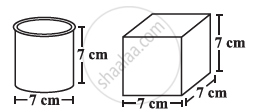Advertisements
Advertisements
प्रश्न
Fill in the blank in the following so as to make the statement true:
1 kl = ........ cu. dm = ........ cu. cm.
उत्तर
\[1 kL = 1000 L = 1000 \times \frac{1}{1000} m^3 = 1 m^3 \]
\[ = 1 m \times 1 m \times 1 m\]
\[ = 10 dm \times 10 dm \times 10 dm ( \because 1 m = 10 dm)\]
\[ = 1000 cu dm\]
\[ = 1000 \times 10 cm \times 10 cm \times 10 cm ( \because 1 dm = 10 cm)\]
\[ = 1000000 {cm}^3 \]
\[ = {10}^6 cu cm\]
APPEARS IN
संबंधित प्रश्न
Describe how the two figures at the right are alike and how they are different. Which box has larger lateral surface area?

Fill in the blank in the following so as to make the statement true:
1 litre = ........ cu. cm
Find the surface area of a cube whose edge is 27 cm.
Find the surface area of a cube whose volume is 216 dm3.
Cubes A, B, C having edges 18 cm, 24 cm and 30 cm respectively are melted and moulded into a new cube D. Find the edge of the bigger cube D.
Total surface area of a cube is 5400 sq. cm. Find the surface area of all vertical faces of the cube.
The ratio between the lengths of the edges of two cubes is in the ratio 3: 2. Find the ratio between their:
(i) total surface area
(ii) volume.
Find the volume of a cube whose diagonals is `sqrt(48)"cm"`.
The base of a rectangular container is a square of side 12 cm. This container holds water up to 2 cm from the top. When a cube is placed in the water and is completely submerged, the water rises to the top and 224 cm3 of water overflows. Find the volume and surface area of the cube.
If the length of the diagonal of a cube is `6sqrt(3)` cm, then the length of the edge of the cube is 3 cm.
